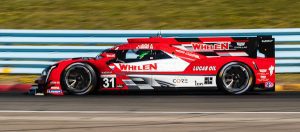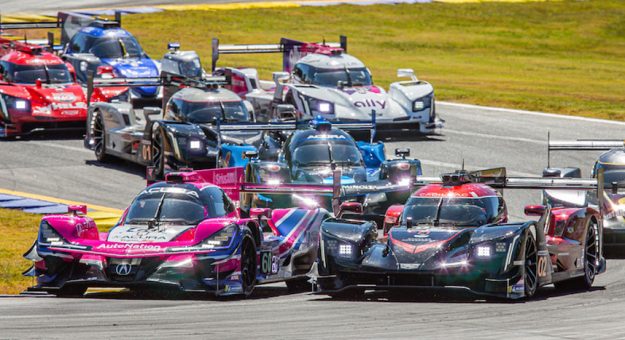The sun has set on IMSA’s Daytona Prototype era.
These cars were a departure from the other prototype series like the original GTP cars and the evolution that drove the teams’ price of admission into a low earth orbit. First it was the Porsche factory 962s, then the Nissans, the purple Jaguars and finally the amazing Gurney Toyotas that put the last shovel of dirt on the GTP grave.
That’s because manufacturers followed the same script in the LMP1 class, which became a factory battle ground … and far too pricey for privateer teams. Amazing cars like the Audi TDi diesels that silently screamed around the tracks, annihilating everything in their path. Private teams were shut out and fans grew weary of these three-car spectacles despite the amazing performance.
All of these cars are wistful memories.
Enter the Daytona Prototype, a much more egalitarian platform that ditched carbon fiber chassis for the tube frame mainstay of most other race cars. And there was a new sanctioning body to run them.
The Grand American Road Racing Ass’n was born. It chucked the exotica, replaced it with the traditional tubular space frame architecture and became the foundation for the first generation of DP race cars. They were a fraction of the cost of their predecessors.
Keeping a tight lid on cost was Grand-Am’s top priority. No more in-season tweaks or private testing. They sacrificed speed for practicality and the fans were treated with a good show.
The Generation I DP cars first rolled in anger at the 2003 24 Hours of Daytona. The first outing was an ignominious display for the new cars. Just six DP cars were on the grid with none on the pole or front three rows. The FIA spec prototypes were the fastest but it was for naught. The Racers Group GT Porsche took home the Rolexes and only two DPs made it to the finish.
The dismal finish forced teams to roll up their sleeves and fix what needed fixing. It wasn’t long before the DP cars started on the front row and on the top step of the podium.
Gary Nelson, boss man at Action Express, was there at the beginning.
“I was there in the very beginning when the first car was built. It was right up my alley. I have been building cars for years, welding steel together and bending roll bars,” Nelson explained. “Then, I got the opportunity to get Coyote and we started building cars together with the Corvette body and the Coyote chassis. Those were some of the more fun memories I have in DP when I started running the Coyote chassis. It was innovating every day doing everything in the building so we could make changes quickly.”
Other teams took note and the DP field ballooned to 17 cars in 2006 and grew to more than 30 a year later. The growth in the class was driven by low cost and simplicity. Grand-Am brass ignored the notion “if it ain’t broke don’t fix it” and changed the rules anyway.
Nelson rolled with the changes. They were very good, he recalled: “We started winning when we ran the Riley chassis and the Coyote chassis came along instead of building our own cars and racing them. I remember running a whole (2014) season and finishing every lap of every race, 12 hours, 24 hours and 10 hours.
“In 2015 we finished the whole season running on the lead lap. In one race we ran the whole race and put a lap on second place. We have a plaque on the wall that says we raced 13,272.789 miles in that season.”
The Generation II cars outlawed the Generation I cars.
Teams could now diddle in some very specific areas, which is hard wired into team engineers.

Wayne Taylor remembers those days and his prototype racing legacy.
Consider this: Wayne Taylor Racing has won two IMSA WeatherTech SportsCar Championships, back-to-back Michelin Endurance Cup Championships (2020 and ’21) and notable endurance victories include four additional Rolex 24 At Daytona wins, three Petit Le Mans victories and one 12 Hours of Sebring win.
“I had just finished Le Mans for Cadillac and was coming back from Le Mans when Grand-Am was formed,” Taylor recalled.
Taylor hooked up with Bill Riley. “We put something together pretty quickly,” Taylor said. “We started in 2004. The thing that I first liked about it was cars were all tube frame chassis, very low technology, very much like NASCAR.
“2005 was a dream year for me,” Taylor said. “I was 29 years old. So for Daytona in 2005 and in the first season we won quite a few races … we came out of the box and won the 24 Hours At Daytona. I was pretty proud of that at my age. In 2006 we came back again but they (Grand-Am) made a big change, the beginning of BoP (Balance of Performance). We weren’t racing for the win because they detuned our engine and I lost my passion at that point. I achieved everything I wanted as a driver.”
There were two endurance sports car series at that time, American Le Mans Series and Grand-Am. Jim France, Grand-Am’s silent but powerful acolyte, coveted the ALMS ACO blessing. So much so he began a long process with ALMS founder Dr. Don Paynoz to merge America’s two most prominent endurance road-racing organizations under one roof. Big time road racing was born again in the 2014 ALMS/Grand-Am merger.
Panoz and France basked in a landmark accomplishment.
Two years earlier, the Daytona Prototypes where updated one more time (Gen III) before the Grand-Am/ALMS merger in 2012. This pitted the DP against the European LMP2 cars in the new Tudor Sports Car Championship, which later took on the iconic IMSA brand. The chance to win overall at Le Mans would not happen until 2023.
The Gen III cars had styling cues pointing to their road car counterparts. Also, the new cars had less restrictive regulations on the car’s design in the side pods and vents. IMSA President John Doonan explained: “The vision of Jim France was, ‘Hey we’ve had manufacturers in the past in GTP. We’ve had manufacturers that have shown enthusiasm in the past and the branding of the Ford. Let’s take that to another level and allow styling cues in a prototype that 100 percent tell a brand story.’”
The DPi cars were the final iteration of the Daytona Prototype. All older generation cars were put out to pasture at the end of the 2015 season.
Doonan shared his insight and said, “In DPi we had Acura, Cadillac, Mazda and Nissan to embrace that and in 2015 I was fortunate to be on the Mazda side and built one of those out with my design. We started those discussions in 2015 before the rollout in 2017.”
The DPi cars were fan magnets. Races were always closely fought, attracting the world’s best drivers. The last two championships literally went down to the wire. It was a fitting end to the Daytona Prototype era.
It was almost not to be. France knows a winner when he sees one and he asked retired driver Wayne Taylor to fly home on his jet.
“I was at Watkins Glen and Jim France asked me to fly home on his jet. On the plane he asked me, ‘Why don’t you start your own team?’” Taylor related. “I told him, ‘I don’t have the money to start my own team.’ He said: ‘Aw, you can buy a truck, buy a trailer, buy a car and if it doesn’t work, just sell it.’”
Taylor did what France urged him to do. That led to the biggest moment in Taylor’s career.
“We won quite a few championships. Then DPi came, I ran Max, Ricky and Jordan and won the 24 Hours (At Daytona) for the second time. That was the highlight of my career, second to that was my win in 1996.”
Now, IMSA stands at the dawn of a new era, where American teams can compete for the overall win at the 24 Hours of Le Mans. But there are many unknowns heading into 2023.
Taylor says it might take a year for the GTP cars to get up to competitive speed.
Buckle up because you haven’t seen anything yet.
